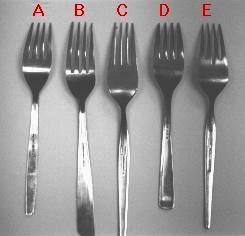Fork Screech Analysis
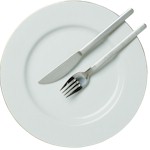
Fork Screech Analysis
by Barry McKinnon
As featured on CBC Radio's Basic Black October 7/2000
Precis
The phenomena of fork screech, or fingernails on a blackboard, are well known
agitators of humankind. This seems to be some fairly basic human response to the
sound quality of a semi-rigid cantilever being excited periodically or aperiodically along
the plane of minimal rigidity. Whether that is a throwback to the response to the sound
of sabre tooth tiger nails on a rock or some even more primitive fear, it is hard to guess.
In the interest of categorizing this sound character, a test procedure was established
using three types of plates, with three different surface finishes, and five types of
stainless steel forks of varying cross-section and tine length. A Techron TEF 12
analyser was used to capture FFT spectra of the fork screech. In all cases the screech
was achieved on a forward thrust of the fork, the most common social faux pas
condition. While the pressure on the fork did vary the spectrum and the amplitude of
the resulting screech, a method and fork/plate attitude was determined to optimize the
output level of each combination. This did not always result in the most distressing
screech, but did provide the most consistent output. The graph data may not convey
the true nature of the screech, the reader may add a visceral sense to the consideration
of this report by chewing on a piece of aluminum foil while viewing the data.
Screech Test Materials
The plates chosen for this test were; Type 1, Corelle; Type 2, stoneware and Type 3,
glass. The Corelle plate is very resonant, a byproduct of a thin cross-section along with
a material having a high work of fracture. This plate has a relatively smooth, low friction
surface. The Stoneware was considerably less resonant, being thicker. The surface
was less smooth than the Corelle and less uniform. The Stoneware produced the most
distressing screech of the three. The Glass plate was quite thick and non-resonant, but
with a very smooth surface.
|

Closeup of this image
The forks were of widely varying construction. Type A was a very thin metal with short
tines, slightly curved in profile. This fork was of noticeably flimsy construction. Type
B was a substantial thickness with long slightly curved tines, the quality of punching
was poor, however, leading to tines of differing tip area. Type C was a heavy metal
punching, with medium length tines that were straight in profile. Type D was an Air
Canada fork, with short curved tines of substantial thickness. Type E was a medium
weight metal with tines of minimal curvature and of varying length, having an extra deep
centre cutaway.
Screech Test Data
The test data is shown with
each fork type (A,B,C,D,E) and a single plate type (1, 2, 3) for comparison. The display
shows the time domain view of the sample and the frequency domain analysis of the
screech. This demonstrates any overall periodicity in the screech signal, showing
modulation, pure tone or a chaotic characteristics. It should be noted that the more
chaotic the screech signal, the more distressing it was to hear.
The tests were made with a B&K 4007 microphone located approximately 4" (100mm)
from the test surface. The TEF FFT was set for a 20kHz bandwidth, providing and FFT
sample length of 7.77 milliseconds. The frequency display is linear with each horizontal
division being l kHz.
Fork A
Test combination 1A:
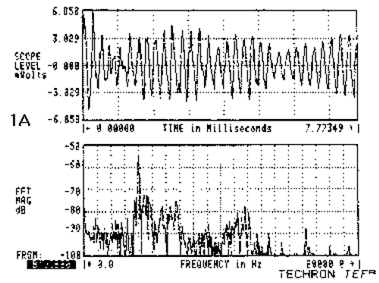
1A: This test combination of a thin fork and a Corelle plate produced a strong fundamental
tone of approximately 4kHz with an overall modulation that produced some sidebands
some 25dB lower in level.
Test combination 2A:
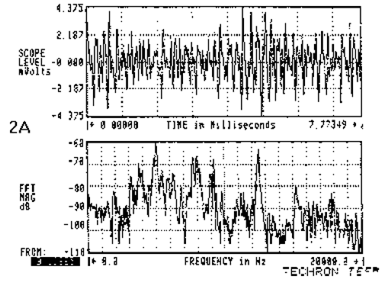
2A:This test combination was noticeably chaotic. Note the extreme amount of energy at
5kHz, 8kHz, 9.2kHz and 12.5kHz. This was a real hackle raiser.
Test combination 3A:
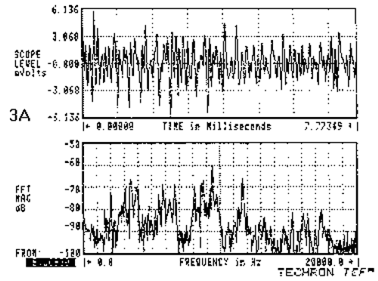
3A:This test combination was extremely chaotic, showing several primary frequencies in
non-harmonically related spacing. Note that there was a predominance of lower
sideband material with each frequency group.
Fork B
Test combination 1 B:

1B:This test combination produced a fundamental of just over 3kHz with other significant
centre frequencies and symmetrical sidebands. There was significant amounts of
energy at 6.5kHz, 9.75kHz and 13kHz. This was a disturbing screech.
Test combination 2B:

2B:This test combination was extremely chaotic. Note the wide band of energy extending
from 3-7kHz and the significant peak at 12.5kHz. This was very unpleasant.
Test combination 3B:
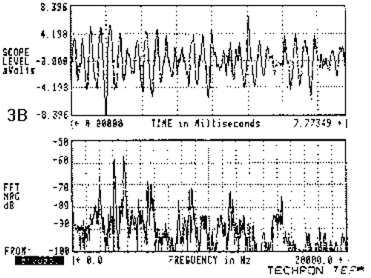
3B:This test combination produced a closely spaced pair of fundamental tones with an
overall modulation that had upper and lower sidebands. Note the extension of
harmonic content to 15.2kHz. This would have had the women cringing.
Fork C
Test combination 1 C:
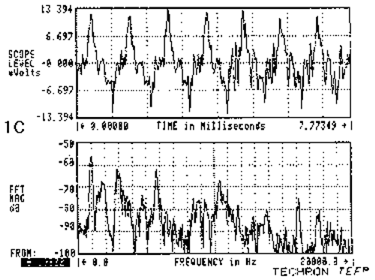
1C:This test combination produced a regular waveform with a fundamental of just below
1 kHz and high harmonic levels at 3kHz, 5.8kHz and 10.4kHz. This was not a pleasant
screech.
Test combination 2C:
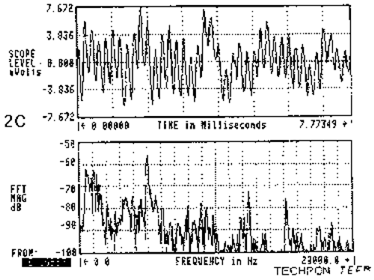
2C:This test combination shows significant variation in pure tones changing over time. A
significant amount of energy between 500Hz and 1kHz, a high level tone at 5kHz and
harmonics at 12.4kHz and 15.1 kHz was distressing to listen to.
Test combination 3C:

3C:This test combination produced a strong fundamental of 2kHz and a secondary at
5.9kHz. There is evidence of an overall envelope modulation and sidebands on the
spectrum display.
Fork D
Test combination 1 D:
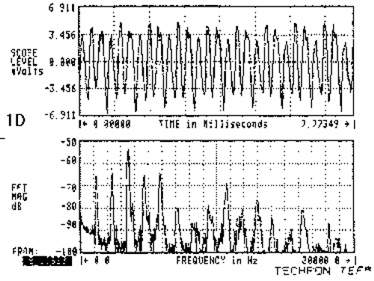
1D:This test combination produced strong intermodulation between two primary
fundamental tones and a modulation. The first fundamental of 3.5kHz and the second
of 10.7kHz have sidetones spaced at 1.2kHz. This was not a pleasant screech.
Test combination 2D:
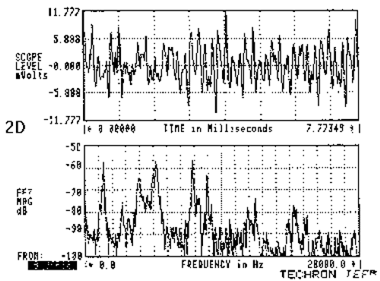
2D:This test combination produced 3 primary and two secondary peaks of energy, at
frequencies of 1.3kHz, 4kHz, 5.2 kHz, 7.9kHz and 9kHz. The effect of this multi-tone
screech were quite unpleasant.
Test combination 3D:
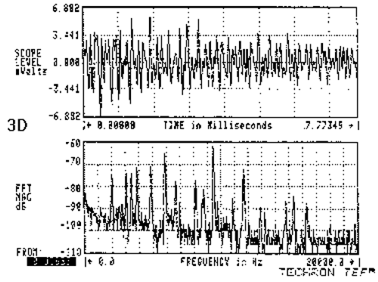
3D:This test combination produced a strong fundamental tone at 9.5kHz with significant
non-harmonic products from 2kHz to 7kHz, and again at 11.7kHz.
Fork E
Test combination 1 E:
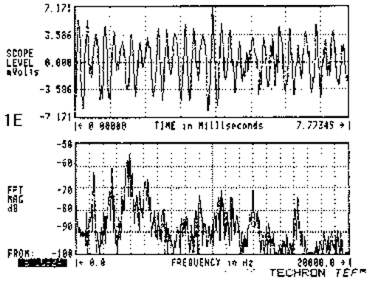
1E:This test combination shows a combination of non-harmonically related tones and an
overall modulating frequency. There was a large amount of energy at 4kHz with
sidebands at 1.2kHz, 2.6kHz and 5.2kHz.
Test combination 2E:
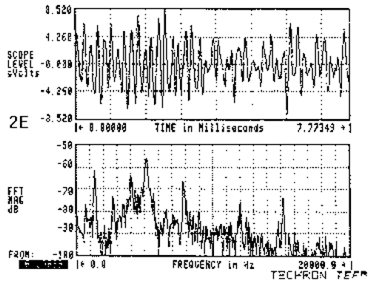
2E:This test combination produced a spectrum very similar in frequency and level
distribution to the previous measurement.
Test combination 3E:

3E:This test combination produced intermodulation products with the centre tones at 3-
4kHz and upper and lower sidebands, including a high level tone at 6and 8kHz.
Discussion
Overall the fork characteristics played a role in the frequency content of the signal. The
thinner tines tended toward chaotic behaviour when excited by a higher friction surface
such as the stoneware. Curved tines were more easily excited, and tend to produce
more non-harmonic tones. The one fork with straight tines tended to display more pure
tone and pure tone combination behaviour and was less prone to chaotic modes of
vibration. The thick tines tend to reduce high frequency content of the signal, leading
to much less distressing sounding screeches. In general, glass produced the most
distressing noises, but stoneware was a big factor in the amount of energy produced
centered at 4-5kHz and producing harmonics beyond 10kHz.
Conclusion
The most screech resistant combination of fork and plate is a fork of thick metal
construction with a straight fork tine profile used on a stoneware plate. The worst case
was a thin metal fork used on a glass plate, which produced the most chaotic and blood
curdling screeches.
Return to All over the map list / Return to the Main Page


|

|
Mc Squared System Design Group, Inc
323 - 901 West 3rd Street, North Vancouver, BC. V7P 3P9 Ph 604-986-8181
116-5100 Anderson Way, Vernon, BC V1T 0C4 Ph 604-986-8181
|

